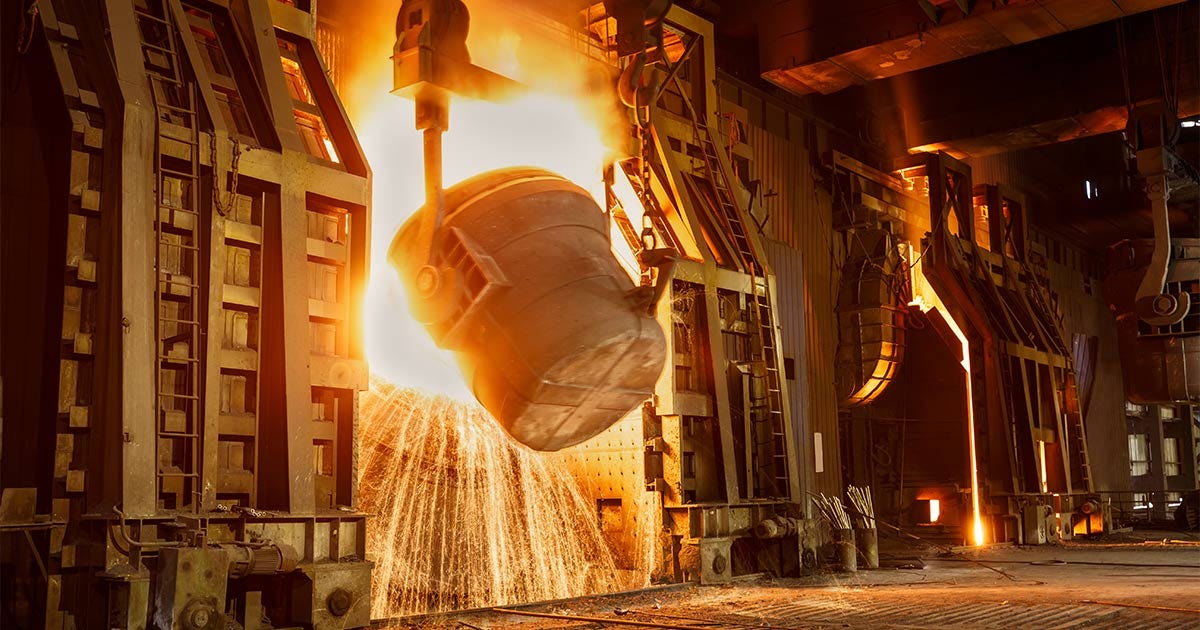Steel production represents more than just an industrial capability - it is a cornerstone of national security, economic resilience, and technological sovereignty. The United States' gradual surrender of domestic steel production capabilities over the past several decades has created critical vulnerabilities in our supply chains, military readiness, and industrial base. This analysis examines why domestic steel production matters, what led to America's manufacturing decline, and which emerging technologies could enable a renaissance in American steel.
Why Domestic Steel Production Is Essential
The capacity to produce primary steel domestically is fundamental to American national security and economic independence for several key reasons:
Supply Chain Security - In 2024, the United States imported approximately 26% of its steel, with significant volumes coming from potential adversaries. During periods of global instability or conflict, these supply lines become vulnerable to disruption, threatening critical infrastructure projects, military readiness, and essential manufacturing.
Military Applications - Steel remains essential for military hardware, from naval vessels to armored vehicles. The specialized steel alloys required for defense applications often have no commercial substitutes. Relying on foreign nations - including potential adversaries - for these materials creates an unacceptable strategic vulnerability.
Industrial Base Resilience - Steel production anchors broader manufacturing ecosystems. When steel mills close, entire supply networks collapse, taking with them skilled labor, technical knowledge, and auxiliary industries. Rebuilding these capabilities during a crisis becomes exponentially more difficult and costly than maintaining them would have been.
Economic Security - Domestic steel production historically provided high-wage jobs for hundreds of thousands of Americans. The industry's decline has contributed significantly to regional economic devastation across the Midwest and Appalachia, with profound social and political consequences.
The Decline of American Steel
America's retreat from steel production was not inevitable but resulted from specific policy choices and market forces:
Global Overcapacity - Beginning in the 1970s, heavily subsidized steel industries in Japan, Korea, and later China flooded global markets with steel priced below production costs. American producers, operating without comparable government support and facing stricter environmental regulations, struggled to compete.
Policy Failures - Rather than implementing a coherent industrial strategy to preserve critical manufacturing capabilities, policymakers embraced a simplistic free-market approach that ignored the strategic implications of deindustrialization. When interventions did occur, they were typically reactive, inconsistent, and insufficient.
Corporate Short-Termism - Many American steel companies failed to invest adequately in modernization during profitable periods, leaving them vulnerable when market conditions deteriorated. Financial engineering often took precedence over operational excellence and long-term viability.
Regulatory Burden Asymmetry - While environmental and labor regulations served important social purposes, the failure to account for regulatory arbitrage between nations created perverse incentives that accelerated offshoring. Steel production didn't become cleaner globally - it simply moved to jurisdictions with fewer protections.
The consequences have been severe. American primary steel production capacity declined from 145 million tons in 1974 to approximately 87 million tons in 2023. Employment in the industry fell from 521,000 in 1974 to under 145,000 today.
Emerging Technologies Enabling Domestic Revival
Several technological advances create new opportunities for competitive domestic steel production:
Hydrogen-Based Direct Reduction - Traditional blast furnaces require metallurgical coal as both a fuel and reducing agent, creating significant carbon emissions. Hydrogen-based direct reduction, which uses hydrogen to remove oxygen from iron ore, can reduce carbon emissions by up to 95% while potentially achieving cost parity with conventional methods as hydrogen production scales.
Electric Arc Furnaces with Smart Controls - Advanced electric arc furnaces equipped with AI-driven control systems can optimize energy usage in real-time, reducing electricity consumption by 15-20% compared to conventional EAFs. These systems also enable faster grade switching and more precise alloying.
Molten Oxide Electrolysis - This emerging technology, pioneered by Boston Metal and other startups, uses electricity to directly convert iron ore to liquid metal without requiring coal or hydrogen. While still at the demonstration phase, MOE could potentially reduce capital intensity and enable smaller, more distributed steel production facilities.
Advanced Materials Characterization - Machine learning techniques combined with advanced materials testing are accelerating alloy development, enabling the creation of steels with superior properties while using less energy and fewer alloying elements.
Carbon Capture and Utilization - For conventional production methods, rapidly improving carbon capture technologies could enable continued operation of existing assets while drastically reducing emissions, creating a bridge to next-generation technologies.
Policy Implications
Revitalizing American steel production will require a coordinated national strategy:
Strategic Investment - Targeted public-private partnerships to commercialize breakthrough technologies and modernize existing facilities.
Skills Development - Programs to rebuild the skilled workforce needed for advanced manufacturing, including apprenticeships and specialized training programs.
Level Playing Field - Trade policies that address market-distorting subsidies by other nations while incentivizing production with high environmental and labor standards.
Procurement Leverage - Expanded domestic content requirements for infrastructure and defense projects to create reliable demand for American steel.
Energy Strategy - Accelerated deployment of clean, abundant energy to power next-generation steel production technologies.
Conclusion
The decline of American steel production was not simply a market outcome but the result of strategic choices that prioritized short-term efficiency over long-term resilience and security. Rebuilding this critical capability is essential not only for national security and economic vitality but also for demonstrating that advanced industrial nations can maintain manufacturing prowess while meeting environmental goals.
With technological innovation, strategic investment, and political will, the United States can rebuild a steel industry that serves as a cornerstone of American industrial strength and security for generations to come.


